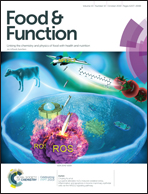Dietary betaine reduces liver lipid accumulation via improvement of bile acid and trimethylamine-N-oxide metabolism in blunt-snout bream†
Abstract
Dietary betaine supplementation notably ameliorated fatty liver disease caused by high dietary carbohydrate. We hypothesised that the mechanism behind this is the alteration of bile acid and trimethylamine-N-oxide (TMAO) metabolism. We further explored this mechanism by supplementing betaine (1%) to the diet of a farmed fish Megalobrama amblycephala. Four diet groups were designed: control (CD, 27.11% carbohydrates), high-carbohydrate (HCD, 36.75% carbohydrates), long-term betaine (HCB, 35.64% carbohydrates; 16 weeks) and short-term betaine (HC4B; 12 weeks HCD + 4 weeks HCB) diets. We analysed the histology of the liver (hematoxylin and eosin staining), the metabolites related to TMAO in plasma (high-performance liquid chromatography-tandem mass spectrometry), the expression of the relative gene in the liver and gut microbiota (qPCR), and the composition of gut microbiota (terminal restriction fragment length polymorphism). HCD elevated lipid accumulation in the liver and decreased the gene expression of bile acid transport, trimethylamine (TMA) formation and the diversity of gut microbiota compared to CD. HCB reversed these patterns, and elevated the gene expression of bile acid receptors and decreased the total cholesterol and TMAO concentration (all compared to HCD). HCD and HCB both increased the gene expression of bile acid synthesis (all p < 0.05). In conclusion, we hypothesise that HCB decreased liver lipid accumulation caused by a high-carbohydrate diet through improvement of the gut microbial community (the diversity of gut microbiota), TMA formation (the expression of associated microbial genes and bacterial taxa), TMAO metabolism (the formation of TMAO) and bile acid metabolism (the gene expression of the synthesis and transport of bile acids and their receptors). HC4B produced intermediate effects of those between HCD and HCB.



 Please wait while we load your content...
Please wait while we load your content...